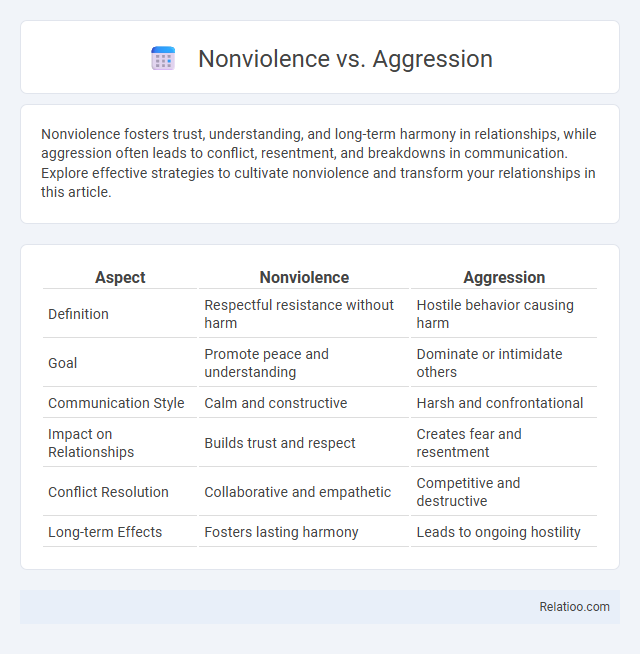Nonviolence fosters trust, understanding, and long-term harmony in relationships, while aggression often leads to conflict, resentment, and breakdowns in communication. Explore effective strategies to cultivate nonviolence and transform your relationships in this article.
Table of Comparison
| Aspect | Nonviolence | Aggression |
|---|---|---|
| Definition | Respectful resistance without harm | Hostile behavior causing harm |
| Goal | Promote peace and understanding | Dominate or intimidate others |
| Communication Style | Calm and constructive | Harsh and confrontational |
| Impact on Relationships | Builds trust and respect | Creates fear and resentment |
| Conflict Resolution | Collaborative and empathetic | Competitive and destructive |
| Long-term Effects | Fosters lasting harmony | Leads to ongoing hostility |
Understanding Nonviolence: Principles and Philosophy
Nonviolence is a philosophy rooted in the principles of respect, empathy, and peaceful conflict resolution, emphasizing the power of compassion over aggression. It advocates for change through dialogue, non-cooperation with injustice, and moral courage without resorting to violence. Understanding nonviolence involves recognizing its strategic use in social movements as a transformative force that dismantles oppression while maintaining human dignity.
Defining Aggression: Forms and Motivations
Aggression manifests in various forms, including physical violence, verbal abuse, and passive-aggressive behaviors, each driven by distinct psychological or social motivations such as frustration, fear, or the desire for control. Understanding these underlying causes helps differentiate aggressive actions from nonviolence, which emphasizes peaceful resistance and empathy. Your awareness of these dynamics can empower more effective conflict resolution and promote a culture of respect and understanding.
Historical Roots of Nonviolence and Aggression
Nonviolence traces its historical roots to ancient philosophies such as Jainism and Buddhism, emphasizing compassion and restraint as paths to social harmony. In contrast, aggression has been historically linked to survival instincts and power struggles observed in tribal and imperial conquests across civilizations. These opposing forces shaped societal norms, with nonviolence influencing movements led by figures like Mahatma Gandhi and Martin Luther King Jr., while aggression often underpinned colonization and warfare.
Psychological Underpinnings: Why Choose Nonviolence or Aggression?
The psychological underpinnings of choosing nonviolence over aggression stem from emotional regulation, empathy development, and conflict resolution skills embedded within your cognitive framework. Nonviolent individuals often exhibit higher levels of self-control and prosocial behavior, driven by neural mechanisms that suppress impulsive aggression and promote understanding. Aggression, linked to heightened amygdala activity and stress responses, may provide immediate assertive outcomes but often escalates conflicts and damages interpersonal relationships, making nonviolence a more sustainable psychological strategy.
Social Impact: Nonviolent Movements vs Aggressive Actions
Nonviolent movements have demonstrated sustained success in achieving social change by fostering widespread participation and minimizing backlash, as evidenced by historical examples like the Civil Rights Movement and India's independence struggle. Aggressive actions often prompt state repression and social divisiveness, undermining long-term goals and alienating potential supporters. Your engagement with nonviolent approaches can amplify social impact by building inclusive coalitions and sustaining moral authority.
Case Studies: Successes and Failures of Nonviolence
Case studies on nonviolence reveal varied outcomes, with the Indian independence movement led by Mahatma Gandhi serving as a landmark success, demonstrating the power of peaceful civil disobedience against British colonial rule. Conversely, the American civil rights movement, while significantly advancing racial equality, also faced violent backlash and limitations in fully eradicating systemic racism. Instances where nonviolence failed, such as the Tiananmen Square protests, highlight the challenges of peaceful resistance against authoritarian regimes that employ aggressive repression.
Aggression in Modern Society: Trends and Consequences
Aggression in modern society manifests through various channels such as social media conflicts, workplace hostility, and urban violence, reflecting deeper psychological and socio-economic stressors. Trends indicate a rise in digital aggression and cyberbullying, exacerbating mental health issues and social fragmentation. The consequences of unchecked aggression include increased community tensions, higher crime rates, and deteriorating interpersonal relationships, emphasizing the need for effective conflict resolution strategies and proactive social policies.
The Role of Leadership in Promoting Nonviolence or Aggression
Leadership plays a critical role in shaping societal behaviors by either promoting nonviolence or endorsing aggression through policies, rhetoric, and example-setting. Effective leaders leverage communication strategies and conflict resolution skills to foster a culture of nonviolence, reducing the incidence of violence and encouraging peaceful coexistence. Contrarily, leaders who endorse aggression often incite conflict and social instability, highlighting the profound impact of leadership styles on societal peace and aggression levels.
Bridging the Divide: Transforming Aggression into Nonviolent Action
Bridging the divide between aggression and nonviolence involves transforming hostile impulses into constructive, peaceful responses that foster understanding and reconciliation. Techniques such as active listening, empathy cultivation, and mindful communication enable individuals to redirect aggression into nonviolent action, promoting social harmony and conflict resolution. This transformation not only reduces immediate violence but also builds resilient communities grounded in mutual respect and cooperation.
Building a Culture of Peace: Strategies for Embracing Nonviolence
Building a culture of peace requires embracing nonviolence as a fundamental strategy that prioritizes empathy, dialogue, and conflict resolution over aggression and hostility. Your commitment to nonviolent practices fosters social cohesion, reduces violence-related trauma, and promotes sustainable harmony within communities. Implementing educational programs and community initiatives focused on active listening and peaceful communication reinforces the global movement towards lasting peace.

Infographic: Nonviolence vs Aggression
 relatioo.com
relatioo.com